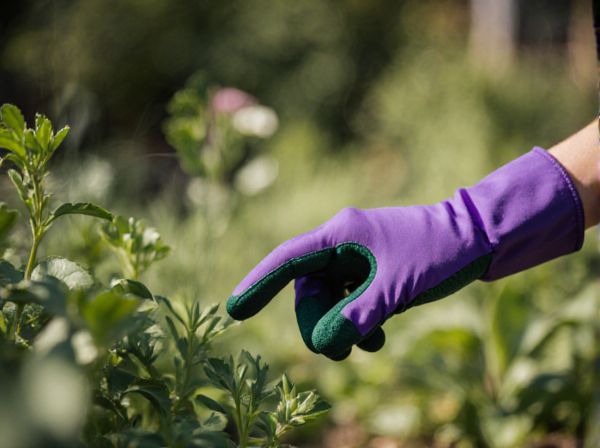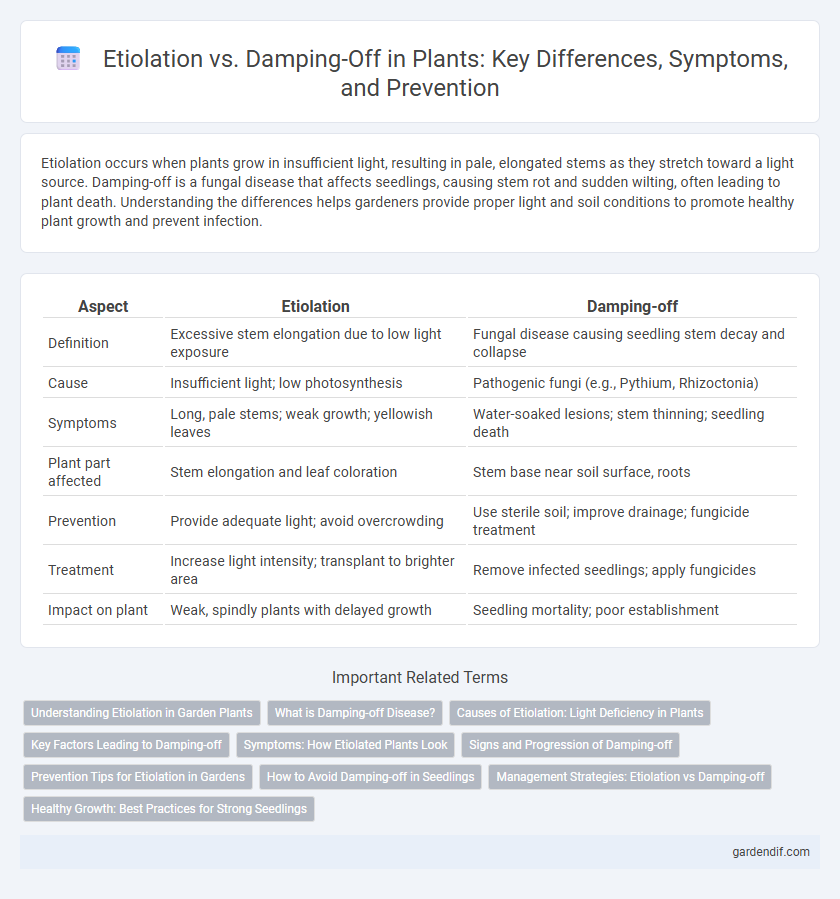
Etiolation vs Damping-off Illustration
Etiolation occurs when plants grow in insufficient light, resulting in pale, elongated stems as they stretch toward a light source. Damping-off is a fungal disease that affects seedlings, causing stem rot and sudden wilting, often leading to plant death. Understanding the differences helps gardeners provide proper light and soil conditions to promote healthy plant growth and prevent infection.
Table of Comparison
| Aspect | Etiolation | Damping-off |
|---|---|---|
| Definition | Excessive stem elongation due to low light exposure | Fungal disease causing seedling stem decay and collapse |
| Cause | Insufficient light; low photosynthesis | Pathogenic fungi (e.g., Pythium, Rhizoctonia) |
| Symptoms | Long, pale stems; weak growth; yellowish leaves | Water-soaked lesions; stem thinning; seedling death |
| Plant part affected | Stem elongation and leaf coloration | Stem base near soil surface, roots |
| Prevention | Provide adequate light; avoid overcrowding | Use sterile soil; improve drainage; fungicide treatment |
| Treatment | Increase light intensity; transplant to brighter area | Remove infected seedlings; apply fungicides |
| Impact on plant | Weak, spindly plants with delayed growth | Seedling mortality; poor establishment |
Understanding Etiolation in Garden Plants
Etiolation in garden plants is a physiological response characterized by elongated stems, pale yellow leaves, and weak growth due to insufficient light exposure. This adaptive mechanism enhances the plant's ability to reach light sources but often results in fragile, unhealthy specimens prone to damage. Differentiating etiolation from damping-off, a fungal disease causing seedling collapse and rot, is crucial for effective garden management and plant health restoration.
What is Damping-off Disease?
Damping-off disease is a soil-borne fungal infection that affects seedlings, causing them to rot at the base and collapse prematurely. It is primarily caused by pathogens such as Pythium, Rhizoctonia, and Fusarium species, which thrive in wet, poorly drained soil conditions. This disease results in significant seedling mortality, hindering plant establishment and crop productivity.
Causes of Etiolation: Light Deficiency in Plants
Etiolation occurs primarily due to light deficiency, causing plants to exhibit elongated stems, pale leaves, and weak growth as they stretch towards available light sources. This physiological response results from insufficient chlorophyll production and reduced photosynthesis, impairing the plant's ability to synthesize energy. Unlike damping-off, which is caused by fungal pathogens affecting seedlings, etiolation is strictly a result of inadequate light exposure during crucial growth stages.
Key Factors Leading to Damping-off
Damping-off is primarily caused by pathogenic fungi such as Pythium, Rhizoctonia, and Fusarium species thriving in overly wet and poorly drained soils. High humidity, low seedling vigor, and contaminated planting media significantly increase the risk of seedling infection and decay. Unlike etiolation, which results from insufficient light causing elongated stems, damping-off directly results from soil-borne pathogens attacking young plant tissue.
Symptoms: How Etiolated Plants Look
Etiolated plants exhibit elongated stems, pale yellowish leaves, and weak, spindly growth due to insufficient light exposure. Their leaves often appear smaller and thinner, with a lack of chlorophyll causing a characteristic pale or yellow color. This distinct morphology helps differentiate etiolation from damping-off, which primarily causes stem rot and seedling collapse.
Signs and Progression of Damping-off
Damping-off in plants is characterized by water-soaked, darkened lesions at the soil line, leading to stem collapse and seedling death. Early signs include wilting and yellowing before seedlings suddenly fall over due to stem rot caused by soilborne pathogens like Pythium, Rhizoctonia, and Fusarium species. The progression is rapid, often killing multiple seedlings within days, severely reducing germination rates and plant establishment.
Prevention Tips for Etiolation in Gardens
Proper spacing and adequate light exposure are essential prevention tips for etiolation, as they encourage robust plant growth and prevent elongation caused by insufficient light. Using grow lights or positioning seedlings near south-facing windows ensures they receive enough intensity to develop strong stems and healthy leaves. Maintaining consistent watering and avoiding overcrowded conditions also minimize stress factors that contribute to etiolation in garden plants.
How to Avoid Damping-off in Seedlings
To avoid damping-off in seedlings, maintain well-drained soil and use sterile planting containers to prevent fungal contamination. Ensure proper air circulation and avoid overwatering by allowing the soil surface to dry slightly between waterings. Plant seeds at the correct depth and apply a light fungicide if necessary to further reduce the risk of damping-off disease.
Management Strategies: Etiolation vs Damping-off
Effective management of etiolation in plants involves optimizing light exposure by providing sufficient natural or artificial light to prevent stem elongation and weak growth. For damping-off, applying fungicide treatments and ensuring well-drained soil conditions reduce seedling infections caused by pathogens like Pythium and Rhizoctonia. Maintaining proper watering practices and avoiding overcrowding are crucial strategies to prevent both etiolation and damping-off in plant cultivation.
Healthy Growth: Best Practices for Strong Seedlings
Etiolation occurs when seedlings grow in low light, causing elongated stems and pale leaves that weaken overall plant vigor. Damping-off is a fungal disease that attacks young seedlings at the soil line, leading to sudden wilting and death, often caused by overly moist conditions and poor air circulation. To ensure healthy growth, provide ample light, maintain well-drained soil, and regulate humidity to prevent etiolation and damping-off, promoting strong, resilient seedlings.
Etiolation vs Damping-off Infographic

 gardendif.com
gardendif.com